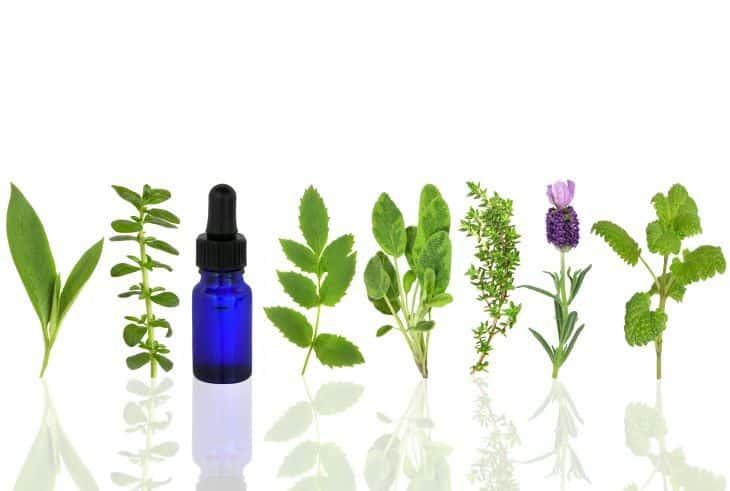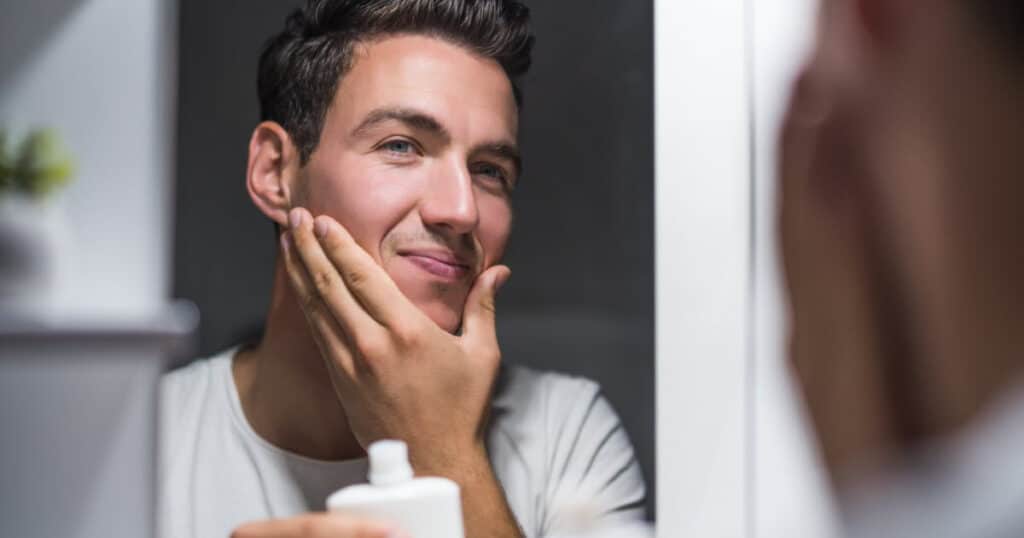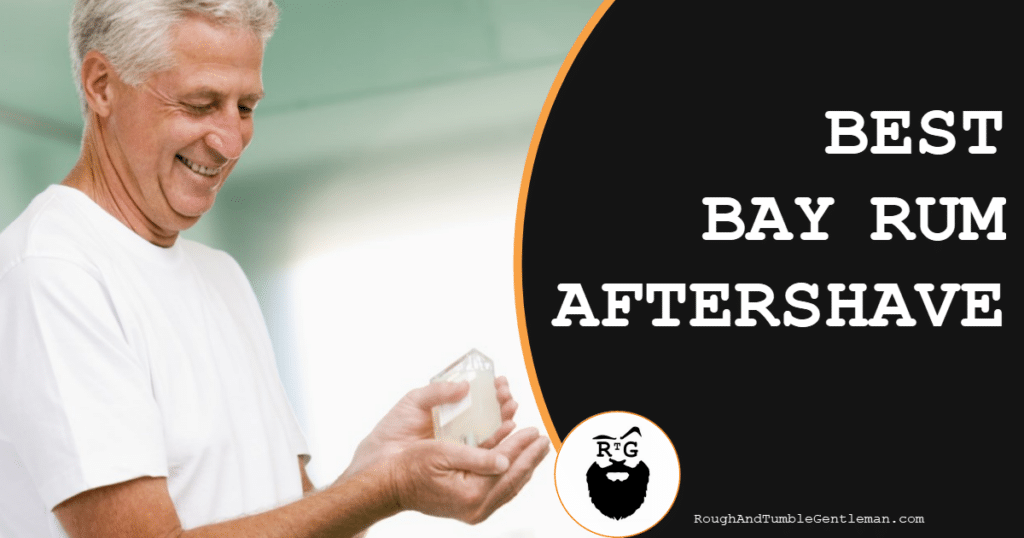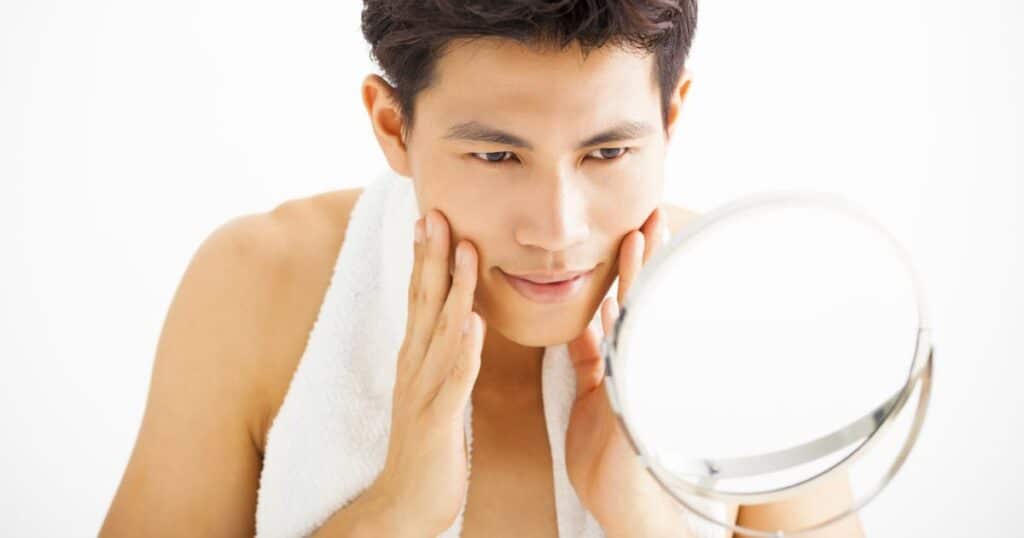Aftershave is a fantastic product to make on your own, because you can design it to be exactly what you want:
Want that bracing ZING! to wake you up after your shave? Create an aftershave splash.
Want something a little more relaxing? Make an alcohol-free spray that’ll gently bring you into your day.
Want to treat yourself, and concoct something to gently apply to your skin after a shave? Make a soothing balm.
In other words—you’ve got options!
Here we’ve got three of our favorite DIY aftershave recipes, including some tips on which might be right for you. Each is pretty simple to make, and after those three, we’ll tell you how you can alter the recipes to make some truly unique and original.

Three DIY Aftershave Recipes
We’ll start with the old-school favorite:
Classic Aftershave Splash
This classic homemade aftershave is designed to resemble those classic, old-school splashes of yester-year. The recipe features alcohol and menthol-rich peppermint essential oils, for that familiar, cooling zing that so many wet shavers love.
Many recipes on the internet suggest you use drinkable alcohol like vodka or rum. We think it’s better to keep the delicious booze in your minibar and use 99% isopropyl alcohol in your recipe, instead. Isopropyl alcohol is more cost-effective, and it’ll also give you more control over the final percentage of alcohol in your homemade aftershave splash.
The recipe also includes witch hazel, known for its soothing touch, and a small amount of hydrating glycerin, which helps to mitigate the drying effects of alcohol and keep the skin a little more resilient.
Ingredients:
1.5 fl. oz. 99% alcohol
0.75 fl. oz. alcohol-free witch hazel
0.25 fl. oz. vegetable glycerin
5-10 drops of peppermint essential oil
Instructions:
Step 1: Combine Alcohol and Scent. To start, pour your alcohol into a cup or directly into the splash or spray bottle you’ll be using. Then, add in the essential oil.
Step 2: Add the Rest. Next, pour in the witch hazel and vegetable glycerin. Seal the bottle, and give the entire mixture a good shake to get everything to combine. Place it somewhere cool and dry, or go ahead and use it right away. If the mixture separates after a few days, just give it another shake before using.

Alcohol-Free Aftershave Spray
You don’t have to give up on making your own aftershave spray just because your skin is a little sensitive to alcohol. It’s possible to make a splash or spray that’s still slightly astringent but alcohol-free.
To make this aftershave spray a little more nourishing to the skin, we also included glycerin and aloe vera in the formula. These natural ingredients help to hydrate the skin, which is important for recovery post-shaving.
Without alcohol, the mix of witch hazel and glycerin can breed pathogens, especially after a few days at room temperature. That’s why we also included a preservative in this formula, so it’ll last you for months rather than just a few days.
If you’d like to avoid preservatives in your aftershave spray then you can simply halve the recipe and make a fresh batch after every two or three shaves.
Ingredients:
2 fl. oz. alcohol-free witch hazel
0.5 fl. oz. aloe vera juice
0.5 fl. oz. vegetable glycerin
0.5 ml Germall Plus (preservative)
5-10 drops of peppermint essential oil
Instructions:
There aren’t too many steps to this recipe! Simply combine all of your ingredients in a spray bottle, and shake it up to mix them. The ingredients may separate after a few days, so make sure to shake it up before every use.

Soothing Aftershave Balm
Aftershave balms have become a lot more popular in the last few years, as we gain a better understanding of what the skin needs after a shave. Instead of stinging the skin with a whiff of booze and menthol, an aftershave balm is made to moisturize and soothe the skin, to help it get over the potential irritation from shaving.
This recipe is a bit of a hybrid between a DIY aftershave lotion and balm. You can increase the butter to oil ratio to achieve a slightly thicker texture, but we give more customization suggestions further below.
This mix is a great choice for most skin types because the oils in it are gentle and not too likely to cause breakouts. It may feel a little greasy if you’re not used to DIY creams, but we give some tips later on Germ all how you can reduce that.
Ingredients:
1 oz shea butter
1 oz jojoba oil
1 oz grape seed oil
1 ml vitamin E
5-10 drops of your favorite essential oil
Instructions:
Step 1: Melt the Oils. Shea is solid at room temperature, so you’ll have to melt it down with the jojoba and grape seed oils to create an even mixture. We recommend using a double boiler or water bath to melt them slowly and gently. Make sure to stir as the oils start to melt.
Step 2: Let Cool. Once the mixture has achieved a cohesive fluid state, take it off the heat and let it cool down. It should still be liquid, but it shouldn’t be too hot to the touch.
Step 3: Add the Scent and Vitamin E. Once your mixture is sufficiently cool, add the essential oils and the vitamin E. Give the mixture a stir so they can blend in properly.
Step 4: Let It Set. Finally, pour your mixture into a sealable jar or tin, and then place it somewhere safe and cool. Within a few hours (or less if you decide to put it in the fridge) your blend will set into a light and creamy balm that’s ready to use.
Optional Step 5: Whip It Up. To get a lighter, more airy DIY aftershave balm, consider whipping your formula once it has set completely. All you need to do is use a hand mixer or immersion blender, and after 5-10 minutes you should have a gloriously fluffy product.
Aftershave Lotion vs Liquid—Which Should You Make?
Should you make a aftershave lotion or a liquid? The answer mostly depends on your skin type, although in our humble opinion, keeping it gentle with an aftershave balm is usually the better choice.
To quickly summarize, aftershave lotions and balms are basically moisturizers designed to lock moisture into the skin and speed up healing after shaving. They’re gentle and nourishing, so they’re especially useful if you have dry or sensitive skin.
Aftershave splashes and sprays take a different approach. They’re astringents, which means that they help constrict or temporarily tighten the skin, which can feel great after the pore-dilating effect of hot water from shaving and may also help to soothe the skin.
Some astringents (namely, alcohol) can also have an antibacterial effect, so they’re used to sanitize the skin after shaving. However, nowadays, most health care professionals don’t recommend using alcohol for wound cleaning because it can be overly drying.
Our alcohol-free aftershave spray recipe is a bridge between the two since it’s designed to have both moisturizing and astringent effects, without any drying alcohol.
If you’re still not sure which recipe to make, we discuss this topic in even more detail in our post on how to use aftershave.
Oh, and by the way, you can also use both, if you like! Use the aftershave balm first, to lock some moisture into your skin, and then layer the aftershave on top for that cooling touch and awesome scent.

Customizing Your Homemade Aftershave Recipe
No matter which kind of aftershave recipe you decide to make, there is still a lot of room to experiment. Here are some ways you may want to customize your creation.
Changing DIY Aftershave Splash Ingredients
A homemade aftershave splash or spray is composed mostly of liquids. Here are the main ones you should consider as you start adapting your recipe.
Astringents. First of all, an aftershave should include some sort of astringent ingredients. Astringents have a constricting effect that may help reduce inflammation and swelling. Some of them are also acidic, so they help to balance the skin’s pH following an alkaline shaving soap.
Alcohol is the most common astringent, but it’s also polarizing. It evaporates quickly, which immediately cools the skin but also pulls away beneficial moisture both in the form of water and oils. If you’re especially prone to nicks and cuts when you shave, it may also sting a little (or a lot). However, if you have oily skin that’s not sensitive, you may enjoy alcohol’s mattifying effect.
Witch hazel is our preferred astringent. It’s rich in tannins, which give a constricting effect similar to alcohol (although you may find that it’s much less bracing). Multiple studies have shown that it can help with irritation, which is what the skin needs after a shave.
Other astringents you can try using include apple cider vinegar, willow bark extract, and even concentrated black tea extract.
Moisturizing Agents. We highly recommend adding a moisturizing agent to your homemade aftershave splash, especially if you have alcohol in your formula. Glycerin is our favorite because it’s affordable, easy to find, and effective. It’s a humectant, which means it acts a bit like a sponge. It holds on to water and then brings it into the skin, to combat dehydration.
Aloe vera juice is another option. It adds a nice boost of moisture, and while it’s not quite as hydrating as glycerin, it has added antioxidant effects that may help soothe your skin post-shave.
There are other hydrating agents you can try, like silk or soy proteins, hyaluronic acid, and even honey.
Preservatives. Water-based liquids and water-binding agents can turn your blend into a haven for bacteria, especially without alcohol in there to destroy pathogens. If you’re making an alcohol-free formula, consider adding a preservative like Germall Plus, Optiphen, or Phenonip.
Changing Your Homemade Aftershave Lotion or Balm
If you choose to take the creamy route, here are a few ways you can alter your homemade aftershave or balm.
Butters are responsible for giving your aftershave lotion some solidity. The more butter you use, the more balm-like your aftershave balm will be, so feel free to increase its ratio if that’s what you prefer. We tend to use shea butter, which is a moisturizing classic, but if you have oily skin you may prefer mango butter which feels a little dryer and more astringent.
Oils. Carrier oils are fluid at room temperature, so they lighten the aftershave lotion and make it easier to spread. We opted for jojoba and grape seed oil in our aftershave balm recipe because they can work well for most skin types, but there are other oils you can try. You may like richer coconut oil if you have dry skin, argan oil for normal skin, or hemp seed oil if your skin is very sensitive.
Wax. Beeswax or vegan candelilla wax can add some firmness to your homemade aftershave balm. If you don’t like an overly creamy recipe, it’s a nice addition that’ll also make your beard balm better at sealing moisture into your skin.
Styptics. Styptics are meant to stop bleeding, and you might be familiar with them as a pen or alum blocks. You can add alum block shavings to your oil and butter double-boiler, which may make your aftershave balm a better remedy for small cuts.
Starch, whether from rice or corn, is a nice addition if you don’t like greasy textures. It’ll help to mattify your aftershave balm a little and it will also add a smooth, silky touch.
Choosing Your Scent
Essential oils imbue your homemade aftershave with a scent, but they also have a physical effect on the skin.
Alcohol-based aftershaves often double as a fragrance, sort of like a weaker cologne. If that’s what you’re looking to create, focus on the fragrance profile of each essential oil, and make sure to also take into account how it might interact with other scented products that you use.
Peppermint is the classic choice for an aftershave because it’s cooling and refreshing. It has a bit of sweetness and it feels clean, so what’s not to love?
Menthol is the isolated organic compound that’s responsible for peppermint’s cooling effect. You can use it on its own to give your aftershave an even stronger bracing touch.
Cedarwood is a woodsy essential oil that’s a classic in masculine fragrance products.
Tea tree is an essential oil with a strong woodsy-herbal scent that’s often described as “medicinal.” It has antibacterial properties, so it may be a great aftershave addition if your skin is acne-prone.
Clary sage is a nuanced herbal scent with a hint of musk.
Lavender is famously considered very soothing both to the mind and the skin. It’s technically a floral, but we think it’s quite unisex.
Chamomile is another soothing choice with a subtle sweet, crisp, and herbal scent.
If you like your aftershave to be more cologne-like, here are some of our favorite essential oil blends to try.
Bay Rum: Bay, orange, allspice, and clove.
Minty Fresh: Peppermint, bergamot, and pine.
Citrus Zing: Orange, bergamot, lime, and lemon.
Clean and Fresh: Pine, lemon, and lavender.
Out of the Woods: Cedarwood, tea tree, and fir.
The Beard Refresh Awaits
So which one will you make? We usually have all three on hand, and use whatever we feel like on any given day. Sluggish? BAM! Splash! Alert but relaxed? Spray. Dreamy and calm? Baaaaaaalm.
Whatever you choose, we hope you have fun making these and feel great using them. Be good, have fun, and happy shaving!
Michael Morris is the head writer here at Rough and Tumble Gentleman. He's got a ducktail beard and loves Brazilian jiu-jitsu. He's married to the woman of his dreams and lives in Brooklyn, NY.




